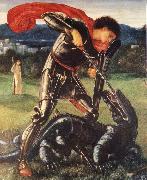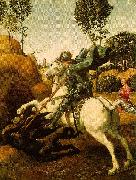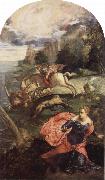
Oil On
Canvas, Real Flavor of Old Masters
|
Gustave Moreau
|
|||
|
|
|||
| French 1826-1898 Moreau's main focus was the illustration of biblical and mythological figures. As a painter of literary ideas rather than visual images, he appealed to the imaginations of some Symbolist writers and artists, who saw him as a precursor to their movement. His father, Louis Jean Marie Moreau, was an architect, who recognized his talent. His mother was Adele Pauline des Moutiers. Moreau studied under François-Édouard Picot and became a friend of Th??odore Chass??riau, whose work strongly influenced his own. Moreau carried on a deeply personal 25-year relationship, possibly romantic, with Adelaide-Alexandrine Dureux, a woman whom he drew several times.[1] His first painting was a Piet?? which is now located in the cathedral at Angoul??me. He showed A Scene from the Song of Songs and The Death of Darius in the Salon of 1853. In 1853 he contributed Athenians with the Minotaur and Moses Putting Off his Sandals within Sight of the Promised Land to the Great Exhibition. Oedipus and the Sphinx, one of his first symbolist paintings, was exhibited at the Salon of 1864. Over his lifetime, he produced over 8,000 paintings, watercolors and drawings, many of which are on display in Paris' Mus??e national Gustave Moreau at 14, rue de la Rochefoucauld (IXe arrondissement). The museum is in his former workshop, and was opened to the public in 1903. Andr?? Breton famously used to "haunt" the museum and regarded Moreau as a precursor to Surrealism. He had become a professor at Paris' École des Beaux-Arts in 1891 and counted among his many students the fauvist painters, Henri Matisse and Georges Rouault. Moreau is buried in Paris' Cimeti??re de Montmartre. In Alan Moore's graphic novel, The League of Extraordinary Gentlemen, it is implied that he was a nephew of Doctor Moreau, and he based a few of his paintings on the Doctor's creations. | |||
|
|
|||
|
|
Saint George and the Dragon new5/Gustave Moreau_vBbSma.jpg Painting ID:: 19539 Visit European Gallery |
1870-89 oil on canvas The National Gallery, London. | |
Height Width |
INS/CM |
||
|
X |
|
||
|
|
|||
|
Sir Edward Coley Burne-Jones
|
|||
|
|
|||
| British Pre-Raphaelite Painter, 1833-1898 English painter and decorative artist. He was the leading figure in the second phase of the Pre-Raphaelite movement. His paintings of subjects from medieval legend and Classical mythology and his designs for stained glass, tapestry and many other media played an important part in the Aesthetic Movement and the history of international Symbolism. | |||
|
|
|||
|
|
Saint George and the Dragon new19/Sir Edward Coley Burne-Jones-896779.jpg Painting ID:: 53456 Visit European Gallery |
mk231 Oil on canvas 1868 106.6x130.8cm | |
Height Width |
INS/CM |
||
|
X |
|
||
|
|
|||
|
Raphael
|
|||
|
|
|||
| Italian High Renaissance Painter, 1483-1520 Raphael Sanzio, usually known by his first name alone (in Italian Raffaello) (April 6 or March 28, 1483 ?C April 6, 1520), was an Italian painter and architect of the High Renaissance, celebrated for the perfection and grace of his paintings and drawings. Together with Michelangelo and Leonardo da Vinci, he forms the traditional trinity of great masters of that period. Raphael was enormously productive, running an unusually large workshop, and, despite his early death at thirty-seven, a large body of his work remains, especially in the Vatican, whose frescoed Raphael Rooms were the central, and the largest, work of his career, although unfinished at his death. After his early years in Rome, much of his work was designed by him and executed largely by the workshop from his drawings, with considerable loss of quality. He was extremely influential in his lifetime, though outside Rome his work was mostly known from his collaborative printmaking. After his death, the influence of his great rival Michelangelo was more widespread until the 18th and 19th centuries, when Raphael's more serene and harmonious qualities were again regarded as the highest models. His career falls naturally into three phases and three styles, first described by Giorgio Vasari: his early years in Umbria, then a period of about four years (from 1504-1508) absorbing the artistic traditions of Florence, followed by his last hectic and triumphant twelve years in Rome, working for two Popes and their close associates. | |||
|
|
|||
|
|
Saint George and the Dragon new26/Raphael-494436.jpg Painting ID:: 94696 Visit European Gallery |
1504-1506 Type Oil on wood Dimensions 28.5 cm x 21.5 cm (11.2 in x 8.5 in) cyf | |
Height Width |
INS/CM |
||
|
X |
|
||
|
|
|||
|
Tintoretto
|
|||
|
|
|||
| Italian Mannerist Painter, ca.1518-1594 His father was a silk dyer (tintore); hence the nickname Tintoretto ("Little Dyer"). His early influences include Michelangelo and Titian. In Christ and the Adulteress (c. 1545) figures are set in vast spaces in fanciful perspectives, in distinctly Mannerist style. In 1548 he became the centre of attention of artists and literary men in Venice with his St. Mark Freeing the Slave, so rich in structural elements of post-Michelangelo Roman art that it is surprising to learn that he had never visited Rome. By 1555 he was a famous and sought-after painter, with a style marked by quickness of execution, great vivacity of colour, a predilection for variegated perspective, and a dynamic conception of space. In his most important undertaking, the decoration of Venice's Scuola Grande di San Rocco (1564 C 88), he exhibited his passionate style and profound religious faith. His technique and vision were wholly personal and constantly evolving. | |||
|
|
|||
|
|
Saint George and the Dragon new26/Tintoretto-384655.jpg Painting ID:: 94787 Visit European Gallery |
1558 Type Oil on canvas Dimensions 157.5 cm x 100 cm (62.0 in x 39 in) cyf | |
Height Width |
INS/CM |
||
|
X |
|
||
|
|
|||










